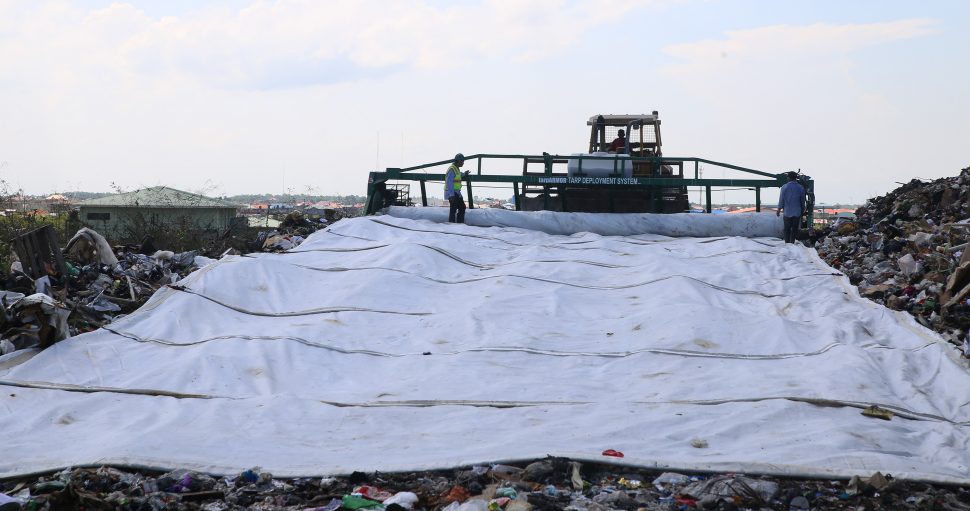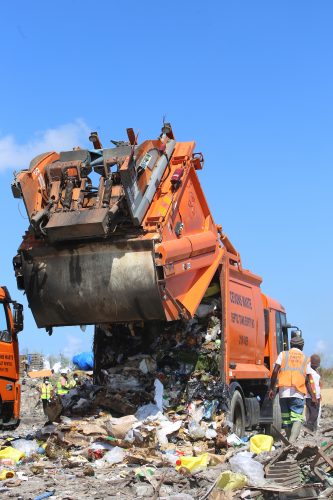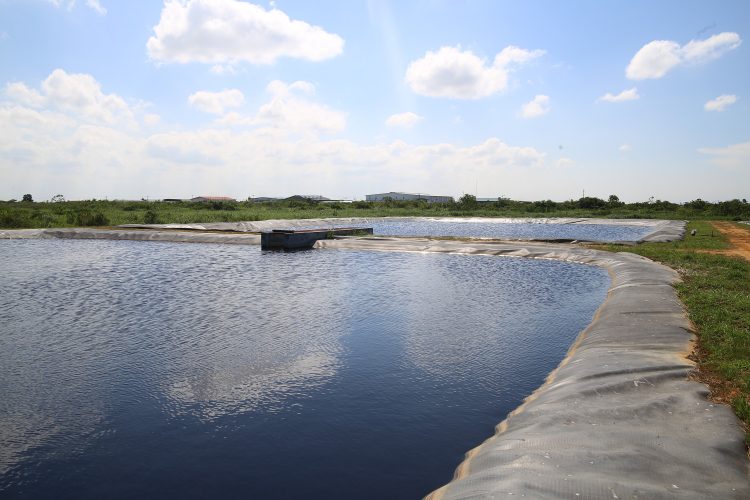Waste Solutions Landfill Inc. has made significant progress in its upgrading the Haags Bosch dumpsite into a landfill, according to Ministry of Communities Site Supervisor Lloyd Stanton, who says that a new space-saving method of storing the waste has been adopted.
Haags Bosch is being managed by the company, which is a joint partnership between Cevons Waste Management Inc and Puran Brothers Waste Disposal Inc., under a one year contract.
During a media tour of the current operations yesterday, hosted by the principals of Waste Solutions Landfill Inc., site manager Hubert Urling explained that they have been getting the job done under the government’s supervision since they took over the management of the site in April of this year.
“The two companies came together with the aim of providing landfill construction and operational services across the country. Haags Bosch is the first major operation that the company has taken over,” he said.
Stanton, who was in charge of the tour, when questioned about the progress made in terms of transforming the site, opined that the management was doing exceptionally well given the limited resources available.
“We have a lot to do to get to ‘First World’ status but getting to ‘First World’ status calls for ‘First World’ money. Some of what is needed now will depend on what systems we want to put in place… there’s always talk about waste to energy [and] right now we are doing some passive venting of the gas and there are safety measures that come with implementing these stuff,” he said, while explaining that ‘First World’ landfills would often do large projects, such as gas collection and intricate leachate treatment, while currently the company is only utilising natural abatement leachate treatment.
When questioned about whether there is a willingness from government to take the landfill to a more advanced level, Stanton related that his interactions with decision makers on the issue indicate that they are interested in doing so, particularly in relation to how the waste is managed.
He also noted that they are currently finalising the Solid Waste Management Strategy, which will set a solidified path for the development of the Haags Bosch and other landfills to be constructed.
Yesterday’s tour began at the first tipping area of the first cell, where garbage is compacted for storage. Stanton pointed out that they have been able to change their method of storing garbage, which has resulted in them saving enough space to cater for more than a year’s worth of generated waste.
Stanton explained that they would initially compact the garbage and then cover it with a 12-inch-thick layer of clay before adding another layer of garbage. This process would then be repeated approximately eight times. As a result, the layers of clay would take up about eight feet of space, which was being wasted.
To address this in order to allow more to be stored in one cell, the company reportedly procured a tarp deployer at a cost of approximately $20 million. The new equipment lays a sheet of thick tarpaulin on the trash that protects it from the elements and vermin and vectors. The cover also eases some of the smell emanating from the garbage, since the tarpaulin is doused with deodorisers before being laid on.
After it is covered, the layer is left overnight and removed in the morning, when more trash is laid over and compacted and the process is repeated.
The second part of the facility Stanton revealed was the Leachate Treatment area or the Garbage Water Treatment Facility, where they treat the waste water and eventually release it back into the waterways.
“After the garbage is placed, compacted and covered, it is left to decompose until it is safe and no longer hazardous… but the decomposing garbage, especially during the rainy season, has [a] high level of moisture that produces a lot of leachate which goes into the drainage system at the bottom of the cell,” Stanton explained.
After it goes into the drainage, it is then carried to the treatment ponds, where it goes through two types of treatment before it is eventually led into the drainage system.
Stanton said that during the rainy season, they pump as much as 10,000 gallons of leachate a day, on average, which drops significantly during the dry season to about 100 gallons per day.
Stanton also touched on their operational health and safety plan and pointed out that all their workers are required to have a mandatory medical check-up every first Tuesday of the month. That initiative is coordinated by the Ministry of Public Health.
“On site we encourage everyone to use their PPE [Personal Protection Equipment] and there are dust masks available. In the areas where there might be toxic and chemicals spills, we have chemical respirators, we have safety boots with steel tip and puncture proof and there are two persons trained in first aid always on site,” he said, before adding that they send about two persons per year to the hospital for check-ups that are rarely related to work being carried out on the site.
“There are some areas we are trying to improve—like getting the drivers to slow down… If they do that during the dry season, then we have a high influx of dust because it is not paved roads. However, we try our best to soak the road as often as possible. There are also wardens and officers that ensure that the litter is picked up off the road; and it is soaked. So we are getting there,” he added.








